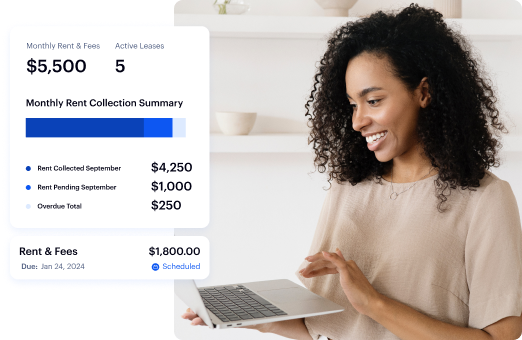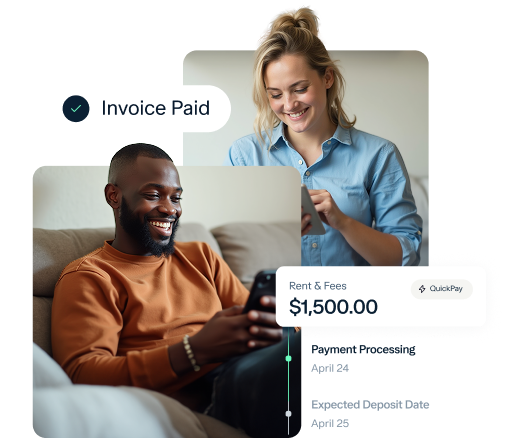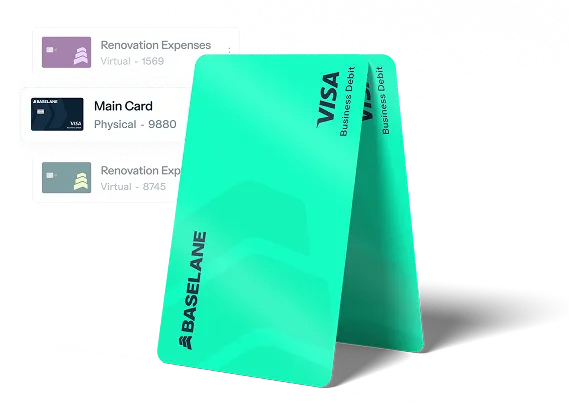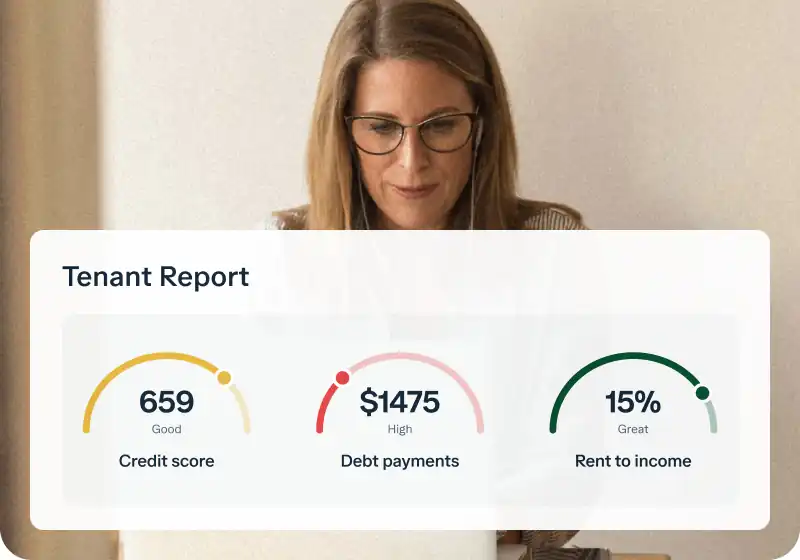Managing accounts payable (AP) for your rental properties often feels like trying to stop a leak with a sieve: endless paper, lost checks, and manual entries that chip away at your time and profits.
Relying on outdated methods like paper checks or expensive wire transfers isn't just inefficient—it actively slows down your ability to scale.
You need a simple, secure method that’s fast, economical, and reliable in processing bills and paying vendors. The Automated Clearing House (ACH) network is that solution, turning your frustrating AP process into a streamlined, automated workflow.
In this guide, we’ll discuss how to leverage ACH for every property expense and share best practices to automate the process.
Key takeaways
- ACH payments are electronic fund transfers that move money directly between bank accounts, making them ideal for recurring bills and vendor payments in property management.
- The primary advantages of using ACH for accounts payable are their low cost, high reliability, and superior security compared to traditional paper checks.
- Best practice is to integrate ACH payments with a banking platform designed for real estate investors to track, categorize, and reconcile every transaction automatically.
What is an ACH payment?
An ACH payment is a type of electronic fund transfer that allows money to move between banks across the Automated Clearing House (ACH) network. You can use ACH for two main functions:
- Direct deposit (Credits): This is typically how you receive funds, such as rent payments from your tenants.
- Direct payment (Debits): This is how you pay your vendors and contractors, or pay recurring bills like mortgages, property taxes, or utility payments.
When you use the ACH network to handle your accounts payable, you authorize your bank to send funds directly from your business checking account to a vendor's bank account.
Why ACH is an ideal payment method for accounts payable
The efficiency of ACH makes it superior to traditional payment methods like paper checks. Here are key reasons why you should ACH for vendor payments.
- Low cost: ACH payments are processed in batches, which reduces the processing fees (< $.50) and typically makes them lower than those for wire transfers or for purchasing and mailing paper checks.
- Speed and reliability: ACH transfers are highly reliable and typically process within a few business days, often with faster options available. Once initiated, you can trust the payment is in the system and on its way to your vendor, minimizing the risk of lost or delayed payments common with paper checks.
- Enhanced security: Unlike checks, which contain sensitive routing and account numbers printed on them, ACH payments transmit data securely within the banking network. This makes them less vulnerable to check fraud, adding a crucial layer of protection to your rental property finances.
What all can you pay using ACH?
Here are the most important and common ways real estate investors leverage ACH for accounts payable (AP):
Recurring operating expenses
ACH is ideally suited for predictable, monthly bills because you can set up automated debits (payments).
- Mortgage payments: Set up ACH for your monthly mortgage payments to ensure you never miss a deadline and secure a consistent payment record for future financing.
- Utility bills: Most utility companies (water, gas, electric, and internet) offer automated ACH debit, allowing funds to be withdrawn directly from your property’s operating account.
- Property insurance: Schedule recurring payments for your landlord insurance or property coverage, which often leads to discounts and ensures continuous coverage.
- Property management fees: If you use a property manager, their monthly retainer or percentage-based fee can be automatically sent via ACH on a scheduled day.
Vendor and contractor payments
Using ACH to pay vendors simplifies the process of compensating service providers, especially when dealing with multiple properties or large invoices.
- Routine maintenance and repairs: Instead of cutting and mailing checks, pay your handyman, plumber, or electrician immediately upon completion of work via direct ACH transfer.
- Bulk payroll: If your business entity has employees, such as an in-house maintenance technician or cleaning crew, ACH is the industry standard for managing payroll via direct deposit.
- Large purchases: Pay suppliers or vendors for large-scale capital improvement projects, such as a new roof or appliance purchase, using scheduled ACH payments directly from your maintenance reserve account.
- Third-party software subscriptions: Pay for the accounting, screening, or lease creation software you use with ACH debits, ensuring uninterrupted access to your core business tools.
Property taxes and fees
ACH is the most economical way to handle non-recurring, large-value government payments compared to expensive wire transfers.
- Property taxes: Schedule large, one-time or semi-annual property tax payments via ACH directly to your local municipal or county government's treasury office.
- Homeowner's Association (HOA) dues: For properties within an HOA, use recurring ACH debits to ensure timely payment of monthly or quarterly dues.
- Permit and licensing fees: Pay for rental licenses, business permits, or inspection fees that your property requires to remain compliant.
How to set up ACH for paying bills
Setting up ACH for your accounts payable is simpler than you might think when you use a platform built for your needs.
Step 1: Obtain vendor banking details
You will need two key pieces of information from each vendor or recipient:
- Routing number: A nine-digit code that identifies their financial institution.
- Account number: The specific account number where they wish to receive the funds.
Read more about how to set up ACH payment for rent.
Step 2: Choose an integrated banking platform
While traditional banks offer ACH, a specialized real estate banking platform will save you the most time and effort.
For instance, Baselane’s banking platform allows you to manage payees and vendors in one place and schedule one-time or recurring ACH payments easily. This saves you time and the headache that comes with last-minute payments and failed transactions.
Step 3: Initiate the payment
Navigate to the payments section of your banking platform. Instead of choosing "wire" or "check," select the option for a direct transfer or ACH payment.
- Input the details: Enter the amount, the vendor’s bank details, and an optional memo for your records.
- Schedule the payment: You can set the payment to be sent immediately or schedule a recurring payment for a set date, such as the 1st of every month, for your mortgage.
ACH accounts payable best practices
While ACH is a simple way to start paying vendors, by following a few best practices, you can reduce your workload and ensure higher transparency in your rental payments.
Dedicate separate virtual accounts for operating expenses
If you run multiple properties, open a dedicated bank account for rental property operating expenses.
For example, instead of having one general account where three different property mortgage payments, six different utility bills, and personal rent all deduct, set up a separate operating expense account for "123 Main St" and another for "456 Oak Ave."
When the utility bill for "123 Main St" is deducted via ACH, the transaction is isolated, instantly proving it's a business expense for that specific property.
Schedule payments for optimal timing
While ACH is reliable, delays can happen (e.g., bank holidays, processing errors). Never schedule a payment for the exact due date. If your property tax bill is due on April 15th and you set the ACH payment for April 15th, and it takes two business days to process, you're officially late.
Schedule important recurring payments (mortgage, property taxes, insurance) at least three business days before the due date. This buffer ensures the funds settle on time, protecting your credit and avoiding late fees.
Automate tax categorization for all payments
Every recurring bill is a critical tax deduction. Don't waste time at year-end matching bank transactions to Schedule E categories.
Use a financial tool with built-in AI bookkeeping that automatically tags mortgage interest, utilities, and property taxes to the relevant Schedule E category upon payment. Baselane's automated bookkeeping auto-tags all transactions by property and over 120 real estate-specific categories, drastically reducing tax preparation time.
Use virtual cards for digital payments and expense control
If you have a lot of online expenses for maintenance and supplies, use virtual debit cards to ringfence spending and instantly track costs.
For every checking or savings account in Baselane, you get a dedicated card for payments. What’s even better is you can set up a custom spend limit and auto-tagging, ensuring a repair expense is immediately and accurately categorized to the correct property and Schedule E category, preventing cost overruns and saving you time on manual reconciliation.
For example, you have a maintenance contractor who buys supplies for three different properties. Instead of giving them your main debit card, issue them a dedicated virtual card. You can set a monthly spending limit of, say, $1,500, and pre-set a rule that all spending on that card is tagged as "Repairs & Maintenance" for your entire portfolio.
Learn more about the best banks that offer free virtual debit cards.
Challenges with ACH payments and mitigation strategies
While ACH is ideal, there are minor drawbacks you should be prepared for:
Start paying bills with ACH
Adopting ACH as your primary method for accounts payable is a non-negotiable step toward professionalizing your rental business. By moving away from manual, high-friction payment methods, you immediately take back time and eliminate common financial errors.
Baselane makes ACH payments seamless by offering dedicated accounts, debit cards, and integrating it with automated bookkeeping, ensuring you can track each payment easily.
Ready to simplify your accounts payable and focus on growing your portfolio? Open your free Baselane banking account today.
FAQs
What is an ACH payment?
An ACH payment is an electronic fund transfer made through the Automated Clearing House network. It facilitates bank-to-bank transactions, commonly used for direct deposits and bill payments.
How long do ACH payments take for accounts payable?
Standard ACH payments typically take 1 to 3 business days to process and settle. Same-Day ACH is available for faster transfers up to $1,000,000, providing a quicker option when needed. Processing time depends on bank cutoff times and network schedules.
Are ACH payments secure for paying property expenses?
Yes, ACH payments are generally considered secure for business transactions when proper protocols are followed. To protect against any potential fraud, use secure platforms, set up approval processes, and have different people handle different parts of a transaction. Also, keep an eye on transactions as they happen.
Can I use ACH to pay all my property vendors?
Most vendors who accept electronic payments can receive ACH transfers. You will need to collect their bank account and routing number and obtain authorization to pay them via ACH.
How does using a banking platform help with ACH for AP?
A banking platform designed for landlords can simplify ACH payments by integrating with your bookkeeping. Baselane allows you to initiate ACH payments directly from your account, automatically categorize transactions, and streamline reconciliation. This saves time and reduces errors compared to manual processes.

















